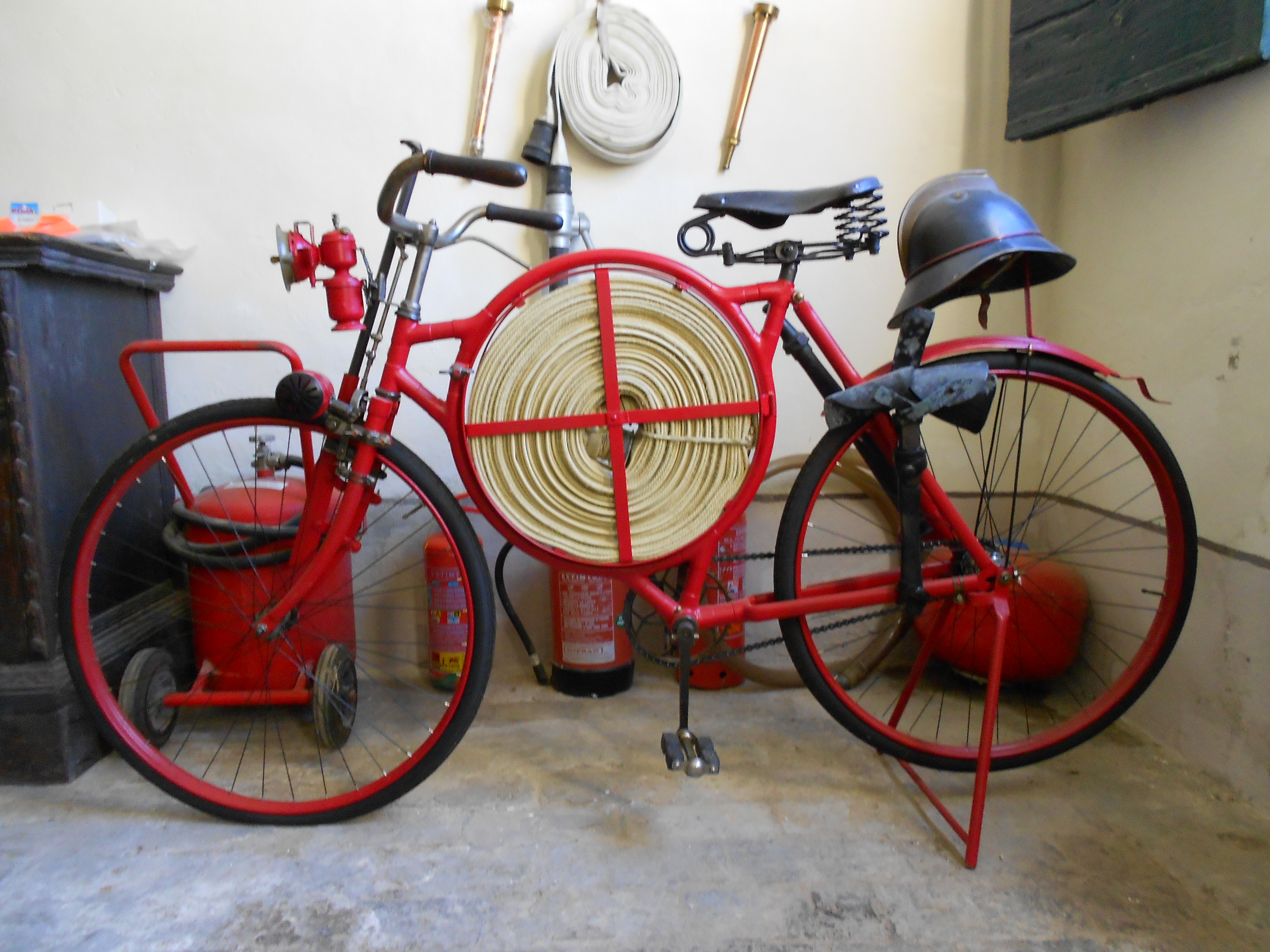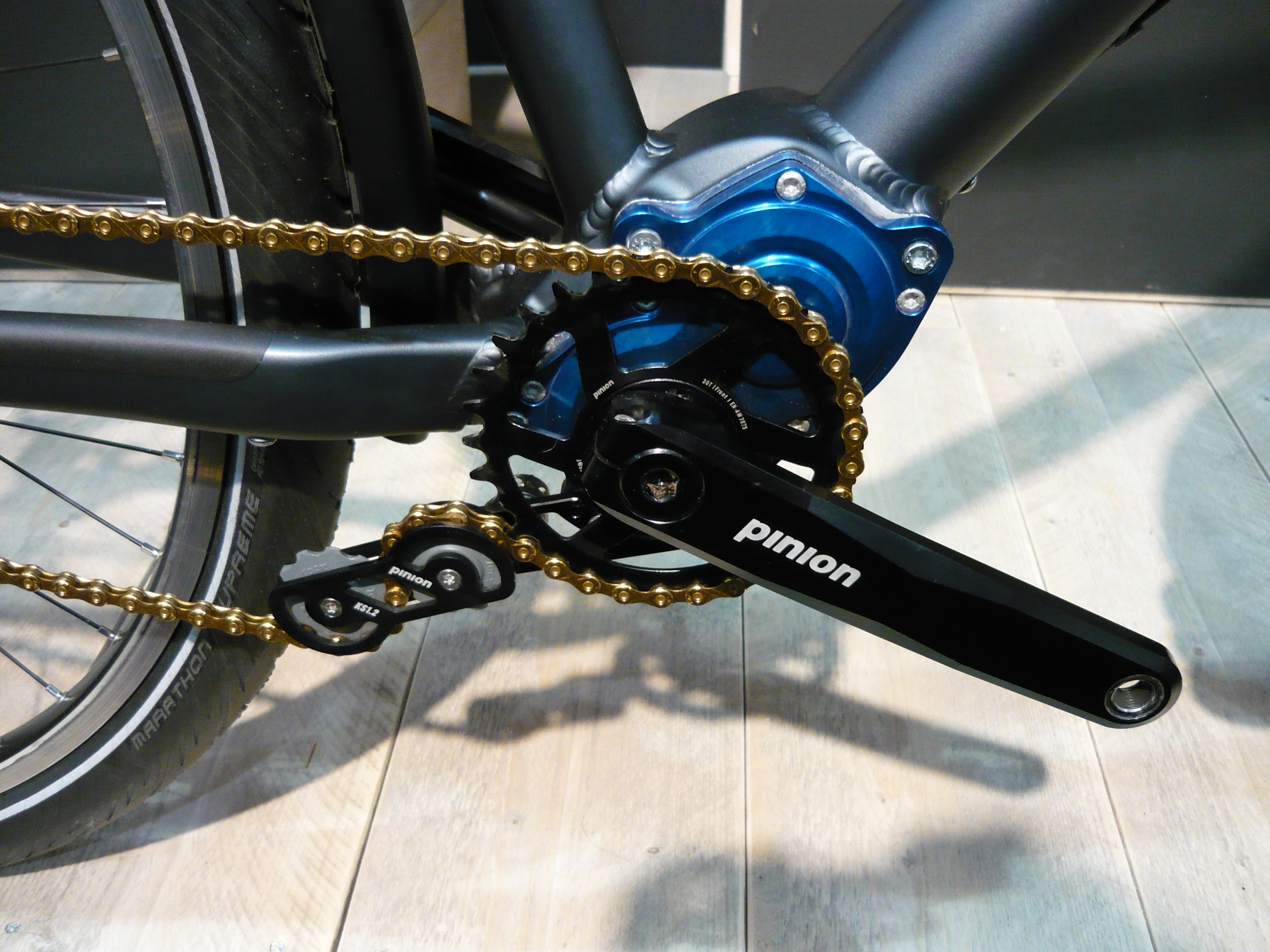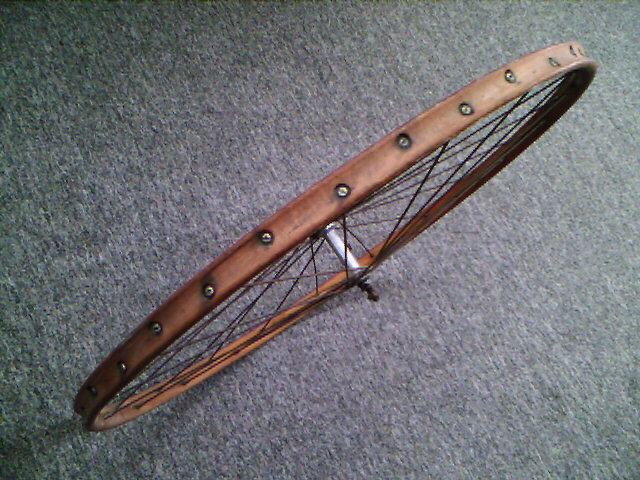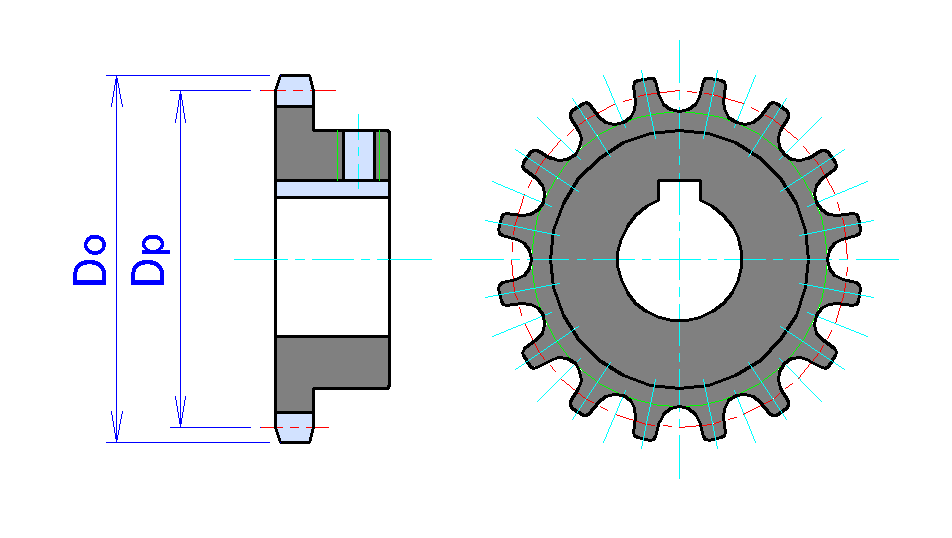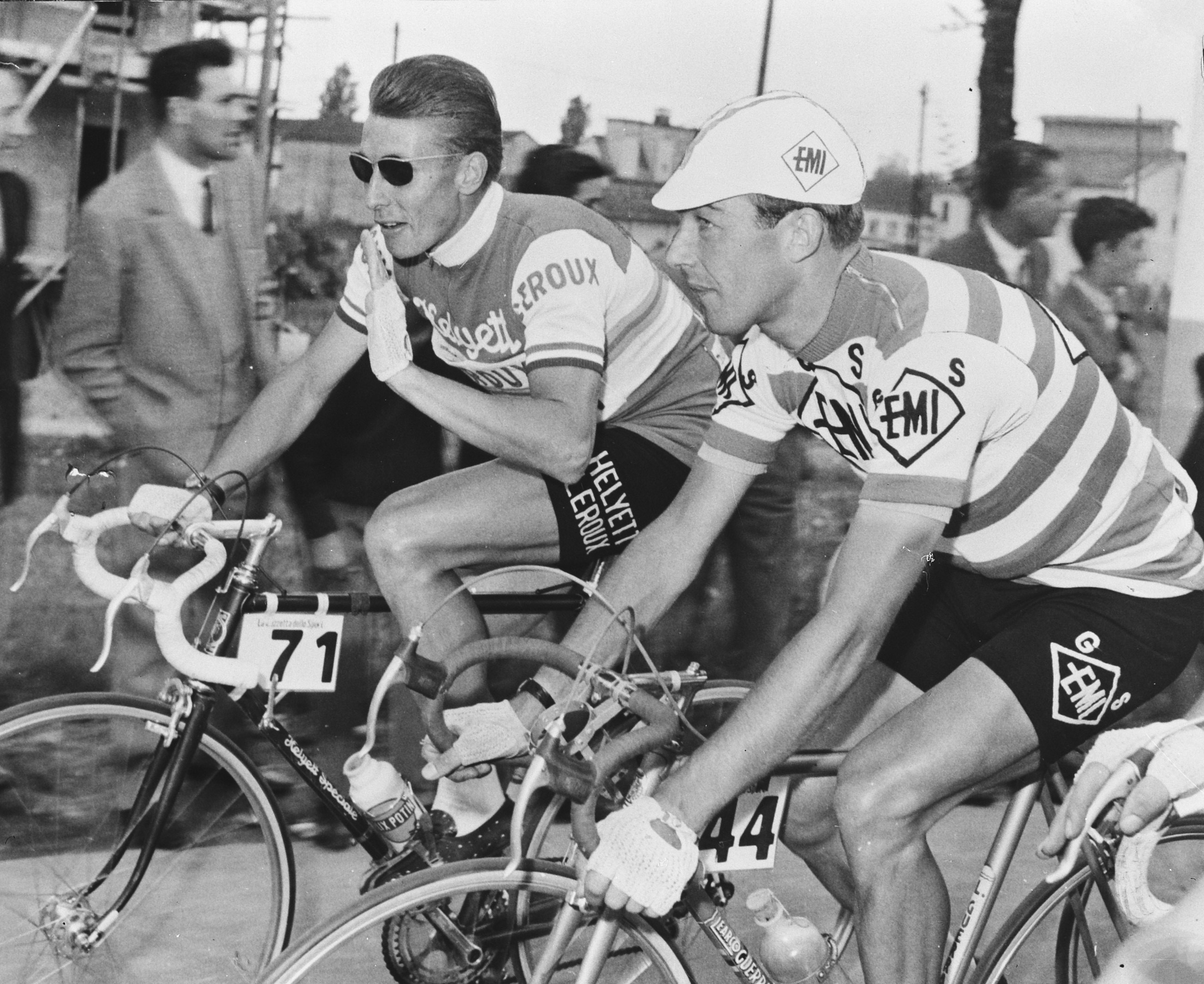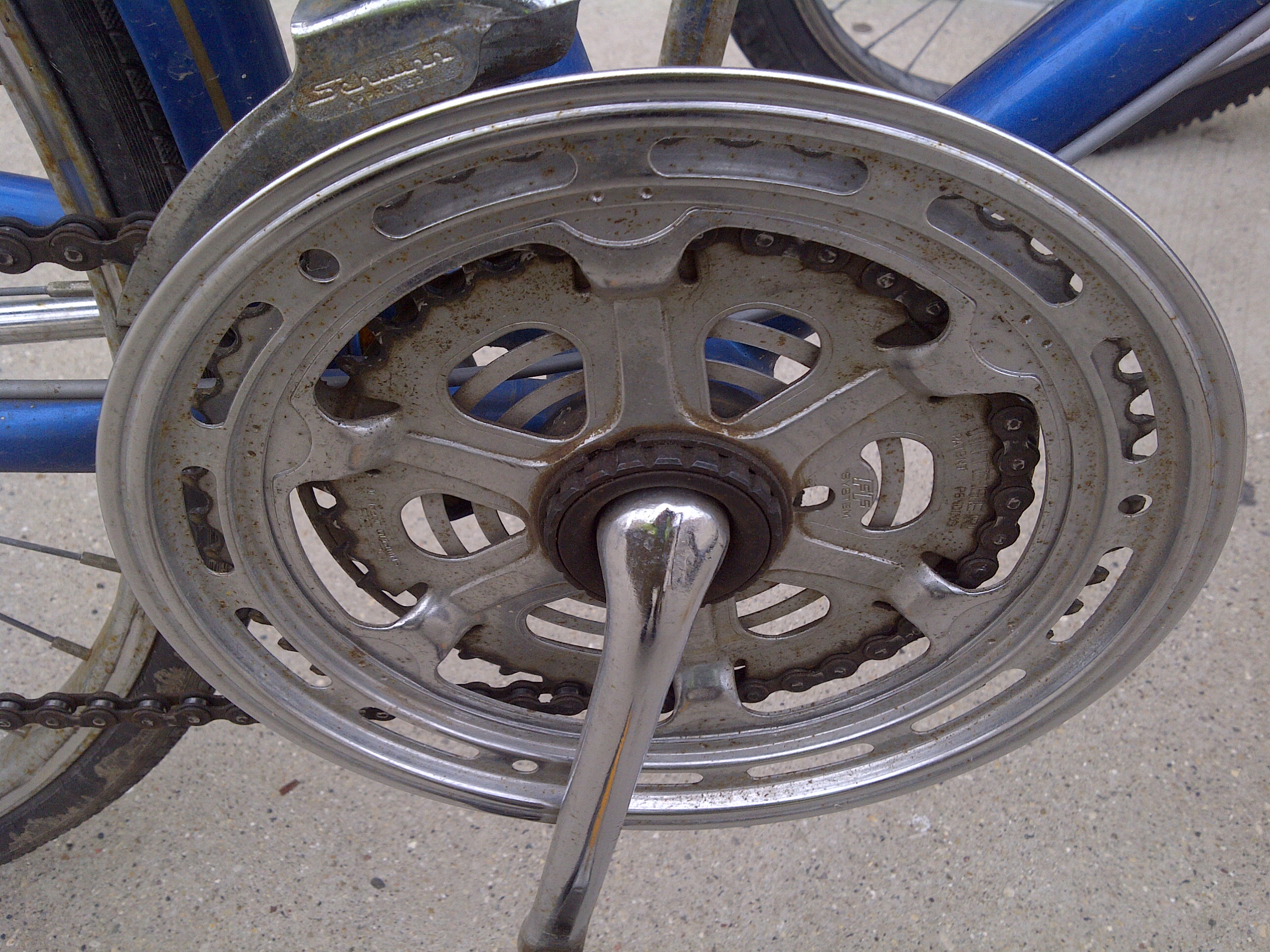|
Cogset
On a bicycle, the cassette or cluster is the set of multiple sprockets that attaches to the hub on the rear wheel. A cogset works with a rear derailleur to provide multiple gear ratios to the rider. Cassettes come in two varieties, freewheels or cassettes, of which cassettes are a newer development. Although cassettes and freewheels perform the same function and look almost the same when installed, they have important mechanical differences and are not interchangeable. Freewheels A freewheel (also known as a block) consists of either a single sprocket or a set of sprockets mounted on a body which contains an internal ratcheting mechanism and mounts on a threaded hub. Threaded rear hubs were available in different thread patterns depending on the country of manufacture, French and British threads being the most common. The British Cycle Engineers Institute (CEI) thread was adopted as the international standard and is now known as British Standard Cycle (BSC). It is a standardi ... [...More Info...] [...Related Items...] OR: [Wikipedia] [Google] [Baidu] |
Freehub
A freehub is a type of bicycle Bicycle wheel#Hub, hub that incorporates a ratchet (device), ratcheting mechanism. A set of sprockets (called a "cassette (bicycle part), cassette") is mounted onto a Spline (mechanical), splined shaft of the freehub to engage the Bicycle chain, chain. The ratcheting mechanism is a part of the hub, in contrast to a Cogset#Freewheels, freewheel, an older technology, which contains both the sprockets and a ratcheting mechanism in a single unit separate from the hub. In many high-end and midrange bicycles, freehubs have replaced freewheel systems. Both freehub and freewheel mechanisms allow a rider to stop pedalling whilst the cycle is still in forward motion. On a cycle without a such a mechanism, the rider has to keep pedalling whenever the cycle is moving. Comparison to freewheels The freehub concept answers several drawbacks encountered with the freewheel design: * Freewheels are threaded onto an axle hub, using conventional right-hand screw thre ... [...More Info...] [...Related Items...] OR: [Wikipedia] [Google] [Baidu] |
Freewheel
image:Freewheel en.svg, Freewheel mechanism In mechanical engineering, mechanical or automotive engineering, a freewheel or overrunning clutch is a device in a transmission (mechanics), transmission that disengages the driveshaft from the driven shaft when the driven shaft rotates faster than the driveshaft. An Overdrive (mechanics), overdrive is sometimes mistakenly called a freewheel, but is otherwise unrelated. The condition of a driven shaft spinning faster than its driveshaft exists in most bicycles when the rider stops Bicycle pedal, pedaling. In a fixed-gear bicycle, without a freewheel, the rear wheel drives the pedals around. An analogous condition exists in an automobile with a manual transmission going downhill, or any situation where the driver takes their foot off the Car controls#Throttle control, gas pedal, closing the throttle: the wheels drive the engine, possibly at a higher RPM. In a two-stroke engine, this can be catastrophic—as many two stroke engines de ... [...More Info...] [...Related Items...] OR: [Wikipedia] [Google] [Baidu] |
Bicycle
A bicycle, also called a pedal cycle, bike, push-bike or cycle, is a human-powered transport, human-powered or motorized bicycle, motor-assisted, bicycle pedal, pedal-driven, single-track vehicle, with two bicycle wheel, wheels attached to a bicycle frame, frame, one behind the other. A is called a cyclist, or bicyclist. Bicycles were introduced in the 19th century in Europe. By the early 21st century there were more than 1 billion bicycles. There are many more bicycles than cars. Bicycles are the principal Mode of transport, means of transport in many regions. They also provide a popular form of recreation, and have been adapted for use as Toy, children's toys. Bicycles are used for Physical fitness, fitness, Military bicycle, military and Police bicycle, police applications, Bicycle messenger, courier services, Cycle sport, bicycle racing, and artistic cycling. The basic shape and configuration of a typical Safety bicycle, upright or "safety" bicycle, has changed lit ... [...More Info...] [...Related Items...] OR: [Wikipedia] [Google] [Baidu] |
Bicycle Wheel
A bicycle wheel is a wheel, most commonly a wire wheel, designed for a bicycle. A pair is often called a wheelset, especially in the context of ready built "off the shelf" performance-oriented wheels. Bicycle wheels are typically designed to fit into the bicycle frame, frame and bicycle fork, fork via Dropout (bicycle part), dropouts, and hold bicycle tires. Invention The first wheel to use the tension in wire wheel, metal spokes was invented by George Cayley, Sir George Cayley to achieve lightness in his 1853 glider. Construction The first bicycle wheels followed the traditions of carriage building: a wooden hub, a fixed steel axle (the bearings were located in the fork ends), wooden spokes and a shrink fitted iron tire. A typical modern wheel has a metal hub, wire tension spokes and a metal or carbon fiber rim which holds a pneumatic rubber tire. Hub A hub is the center part of a bicycle wheel. It consists of an axle, bearing (mechanical), bearings and a hub shell. The ... [...More Info...] [...Related Items...] OR: [Wikipedia] [Google] [Baidu] |
Derailleur Gears
Shimano 600 front derailleur (1980) A derailleur () is a variable-ratio bicycle gearing system consisting of a chain, multiple sprockets of different sizes, and a mechanism to move the chain from one sprocket to another. Modern front and rear derailleurs typically consist of a moveable chain-guide that is operated remotely by a Bowden cable attached to a shifter mounted on the down tube, handlebar stem, or handlebar. When a rider operates the lever while pedalling, the change in cable tension moves the chain-guide from side to side, "derailing" the chain onto different sprockets. Etymology ''Dérailleur'' () is a French word, derived from the derailment of a train from its tracks. Its first recorded use was 1930. History A modern road bicycle drivetrain with front and rear derailleurs Various derailleur systems were designed and built in the late 19th century. One example is the Protean two-speed derailleur available on the Whippet safety bicycle. The Fren ... [...More Info...] [...Related Items...] OR: [Wikipedia] [Google] [Baidu] |
Bicycle Gearing
Bicycle gearing is the aspect of a Bicycle drivetrain systems, bicycle drivetrain that determines the relation between the cadence (cycling), cadence, the rate at which the rider pedals, and the rate at which the drive Bicycle wheel, wheel turns. On some bicycles there is only one gear and, therefore, the gear ratio is Single-speed bicycle, fixed, but most modern bicycles have multiple gears and thus multiple gear ratios. A Shifter (bicycle part), shifting mechanism allows selection of the appropriate gear ratio for efficiency or comfort under the prevailing circumstances: for example, it may be comfortable to use a high gear when cycling downhill, a medium gear when cycling on a flat road, and a low gear when cycling uphill. Different gear ratios and gear ranges are appropriate for different people and styles of cycling. A cyclist's legs produce power optimally within a narrow pedalling speed range, or cadence. Gearing can be optimized to use this narrow range as efficiently ... [...More Info...] [...Related Items...] OR: [Wikipedia] [Google] [Baidu] |
Derailleur
Shimano 600 front derailleur (1980) A derailleur () is a variable-ratio bicycle gearing system consisting of a chain, multiple sprockets of different sizes, and a mechanism to move the chain from one sprocket to another. Modern front and rear derailleurs typically consist of a moveable chain-guide that is operated remotely by a Bowden cable attached to a shifter mounted on the down tube, handlebar stem, or handlebar. When a rider operates the lever while pedalling, the change in cable tension moves the chain-guide from side to side, "derailing" the chain onto different sprockets. Etymology ''Dérailleur'' () is a French word, derived from the derailment of a train from its tracks. Its first recorded use was 1930. History A modern road bicycle drivetrain with front and rear derailleurs Various derailleur systems were designed and built in the late 19th century. One example is the Protean two-speed derailleur available on the Whippet safety bicycle. The French bicyc ... [...More Info...] [...Related Items...] OR: [Wikipedia] [Google] [Baidu] |
Bicycle Wheel
A bicycle wheel is a wheel, most commonly a wire wheel, designed for a bicycle. A pair is often called a wheelset, especially in the context of ready built "off the shelf" performance-oriented wheels. Bicycle wheels are typically designed to fit into the bicycle frame, frame and bicycle fork, fork via Dropout (bicycle part), dropouts, and hold bicycle tires. Invention The first wheel to use the tension in wire wheel, metal spokes was invented by George Cayley, Sir George Cayley to achieve lightness in his 1853 glider. Construction The first bicycle wheels followed the traditions of carriage building: a wooden hub, a fixed steel axle (the bearings were located in the fork ends), wooden spokes and a shrink fitted iron tire. A typical modern wheel has a metal hub, wire tension spokes and a metal or carbon fiber rim which holds a pneumatic rubber tire. Hub A hub is the center part of a bicycle wheel. It consists of an axle, bearing (mechanical), bearings and a hub shell. The ... [...More Info...] [...Related Items...] OR: [Wikipedia] [Google] [Baidu] |
Sprocket
A sprocket, sprocket-wheel or chainwheel is a profiled wheel A wheel is a rotating component (typically circular in shape) that is intended to turn on an axle Bearing (mechanical), bearing. The wheel is one of the key components of the wheel and axle which is one of the Simple machine, six simple machin ... with teeth that mesh with a chain, rack and pinion, rack or other perforated or indented material. The name 'sprocket' applies generally to any wheel upon which radial projections engage a chain passing over it. It is distinguished from a gear in that sprockets are never meshed together directly, and differs from a pulley in that sprockets have teeth and pulleys are smooth except for timing pulleys used with toothed belts. Sprockets are used in bicycles, motorcycles, continuous track, tracked vehicles, and other machinery either to transmit rotary motion between two shafts where gears are unsuitable or to impart linear motion to a track, tape etc. Perhaps the most commo ... [...More Info...] [...Related Items...] OR: [Wikipedia] [Google] [Baidu] |
Glossary Of Cycling
This is a glossary of terms and jargon used in cycling, mountain biking, and cycle sport. For ''parts of a bicycle'', see List of bicycle parts. 0–9 ; 27.5 Mountain bike: A mountain bike with wheels that are approximately in diameter and are based on ISO 584 mm (650B) rims. ; 29er (bicycle):A mountain bike with wheels that are approximately in diameter and are based on ISO 622 mm (700C) rims. ;3:1 rule : A UCI rule stating the depth and breadth (in cross-section) of the bicycle frame tubes cannot exceed the ratio of 3:1. A ; À bloc: Going ''à bloc'' means riding as hard as one possibly can, which can be risky as it leaves one in a state where recovery is needed, and therefore vulnerable to being attacked. ; Abandon: To leave a race prior to its completion - as the rider is unable to finish (for example, because of a crash or injury). ; Aero bars: Extension of the handlebars usually allowing the rider to rest their elbows and benefit from improved aerodyn ... [...More Info...] [...Related Items...] OR: [Wikipedia] [Google] [Baidu] |
Cycling
Cycling, also known as bicycling or biking, is the activity of riding a bicycle or other types of pedal-driven human-powered vehicles such as balance bikes, unicycles, tricycles, and quadricycles. Cycling is practised around the world for purposes including transport, recreation, exercise, and competitive sport. History Cycling became popularized in Europe and North America in the latter part and especially the last decade of the 19th century. Today, over 50 percent of the human population knows how to ride a bike. War The bicycle has been used as a method of reconnaissance as well as transporting soldiers and supplies to combat zones. In this it has taken over many of the functions of horses in warfare. In the Second Boer War, both sides used bicycles for scouting. In World War I, France, Germany, Australia and New Zealand used bicycles to move troops. In its 1937 invasion of China, Japan employed some 50,000 bicycle troops, and similar forces were instrumental in ... [...More Info...] [...Related Items...] OR: [Wikipedia] [Google] [Baidu] |
Front Freewheel
A front freewheel or freewheel crank is a freewheel mechanism used on some bicycles which enables the drivetrain of the bicycle to continue spinning while the rider rolls, but stops pedaling, or ''coasts''. Unlike regular bicycles, a front freewheel can make it possible to shift gears using a derailleur while the rider is coasting if paired with a fixed rear hub or a freehub with a slight resistance in the freewheel mechanism, which causes the chain to continue spinning with the wheel rotation. Freewheels in bottom brackets have been used on some pedelec and are necessary parts for all mid-drive systems to allow the electric motors to work inside their optimal rotational speed ranges. A mid-mounted motor is mounted near the crankset, as opposed to a front-mounted motor, which sits in the front hub, or a rear-mounted motor, which sits in the rear hub. History The Shimano Front Freewheel (FFS) was a proprietary bicycle drivetrain design of the 1970s that placed a freewheel betwee ... [...More Info...] [...Related Items...] OR: [Wikipedia] [Google] [Baidu] |

